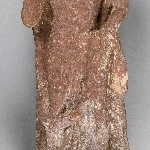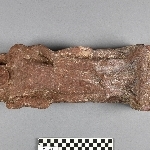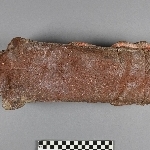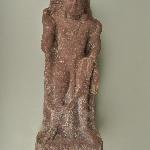| Object Number | 29-64-4 |
| Current Location | Collections Storage |
| Culture | Indian | Hindu |
| Provenience | India | Mathura |
| Date Made | 1st Century - 2nd Century |
| Section | Asian |
| Materials | Mathura Sandstone | Red Sandstone |
| Technique | High Relief | Carved |
| Iconography | Shiva | Abhaya Mudra |
| Inscription Language | Brahmi Script |
| Description | This early and rare image shows the Hindu god Shiva standing on an inscribed base in front of a garland-bedecked pillar presenting his phallic emblem (linga). Dressed simply, wearing a crown, earrings, necklace, and bracelets, the figure is virtually identical in its stance and gestures with images of other deities produced from the same mottled red sandstone during the early centuries CE at Mathura. The god raises his right hand in the gesture of assurance (abhaya mudra) and holds the end of his robe with his left hand. This modest sized image was produced by sculptors who serviced an ever changing community of pilgrims who came to Mathura, then a major religious center for all the great religions of India. A votive icon, this image like many others was commissioned by a pilgrim to obtain merit, to fulfill a promise made to the god or to guarantee some material benefit now or in the future. The image has a tenon projecting from it's base that indicates that it was originally part of a larger monument. |
| Height | 49.5 cm |
| Length | 15.2 cm |
| Credit Line | Alexander Scott Expedition to India, 1915-1918 |
Report problems and issues to digitalmedia@pennmuseum.org.






